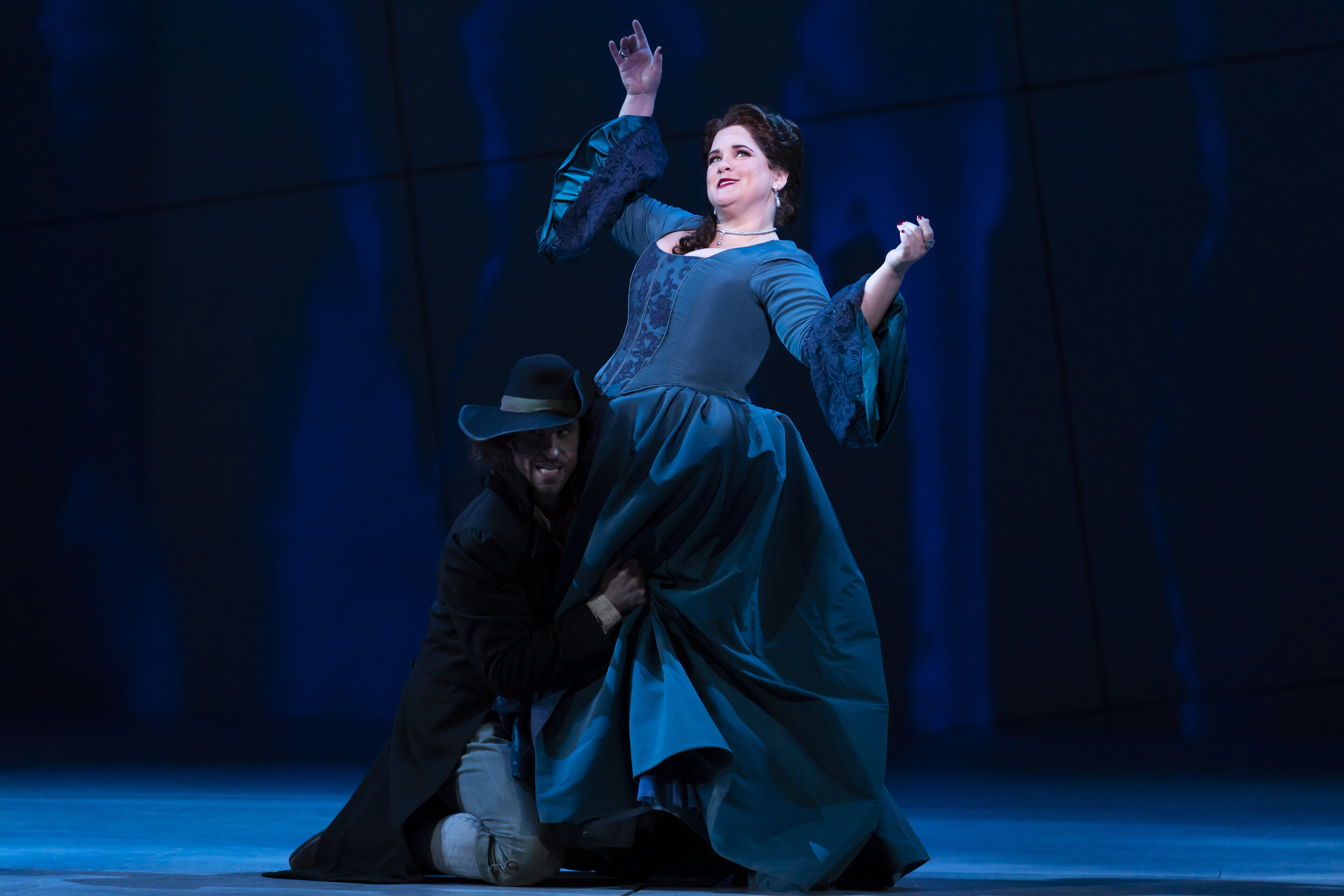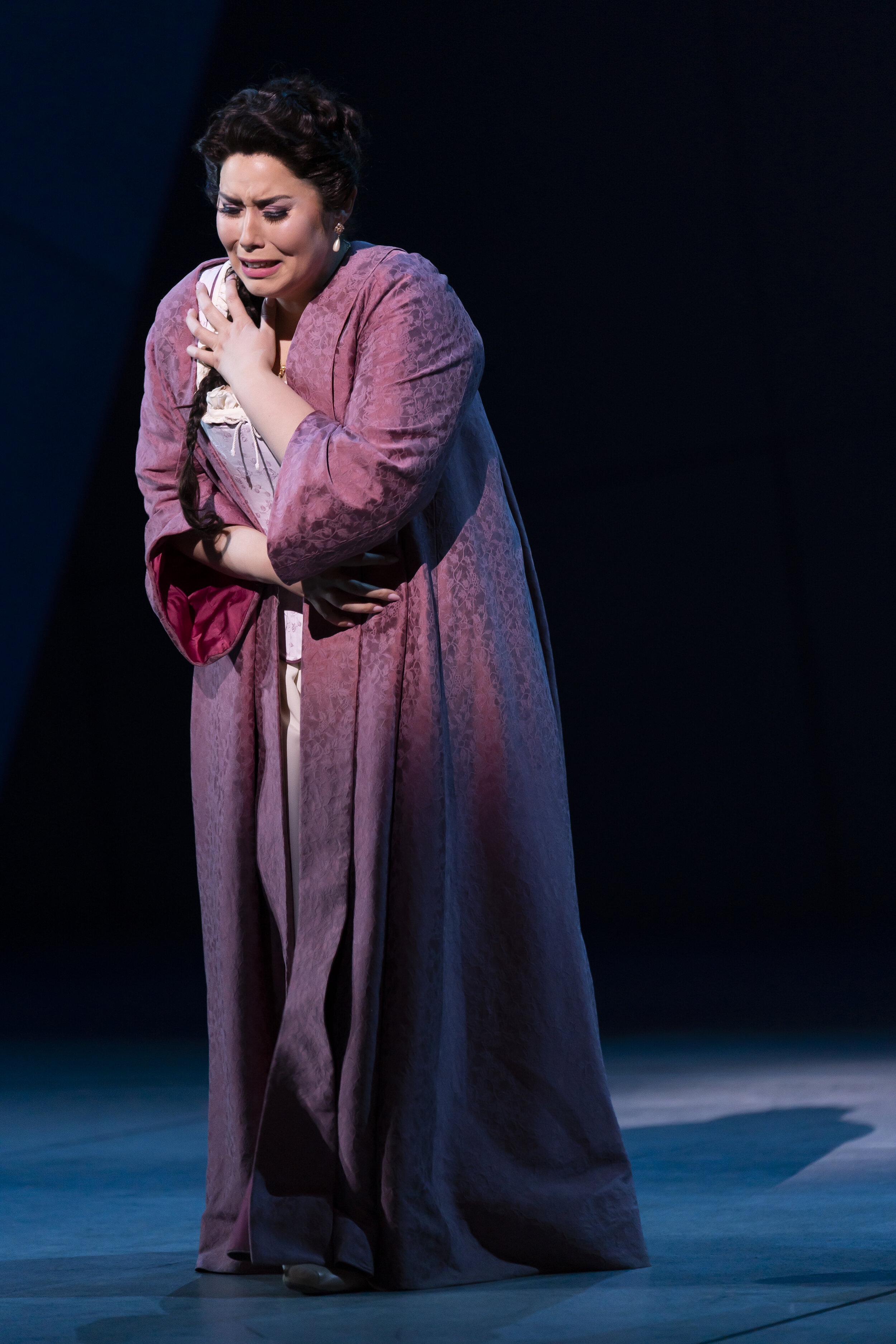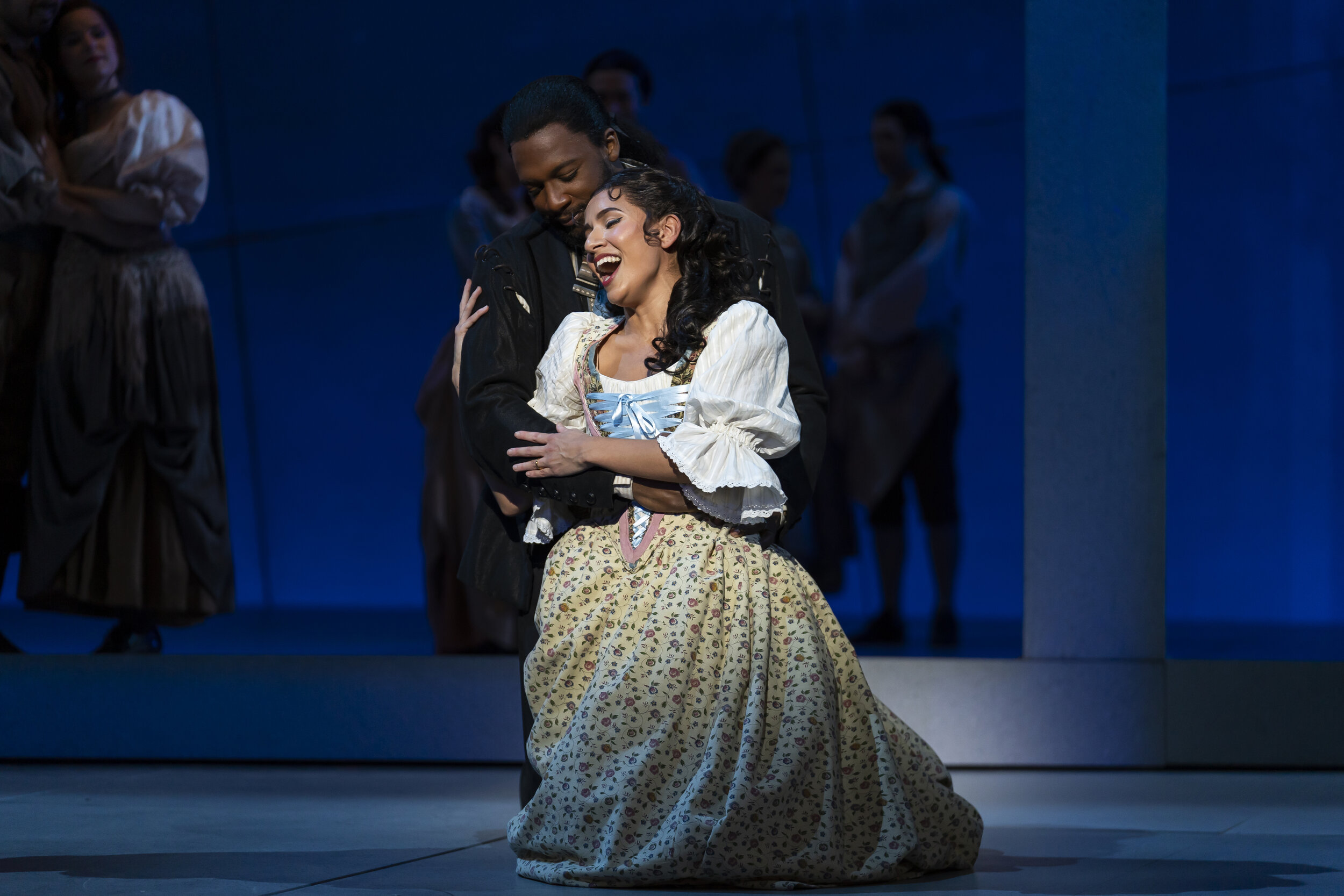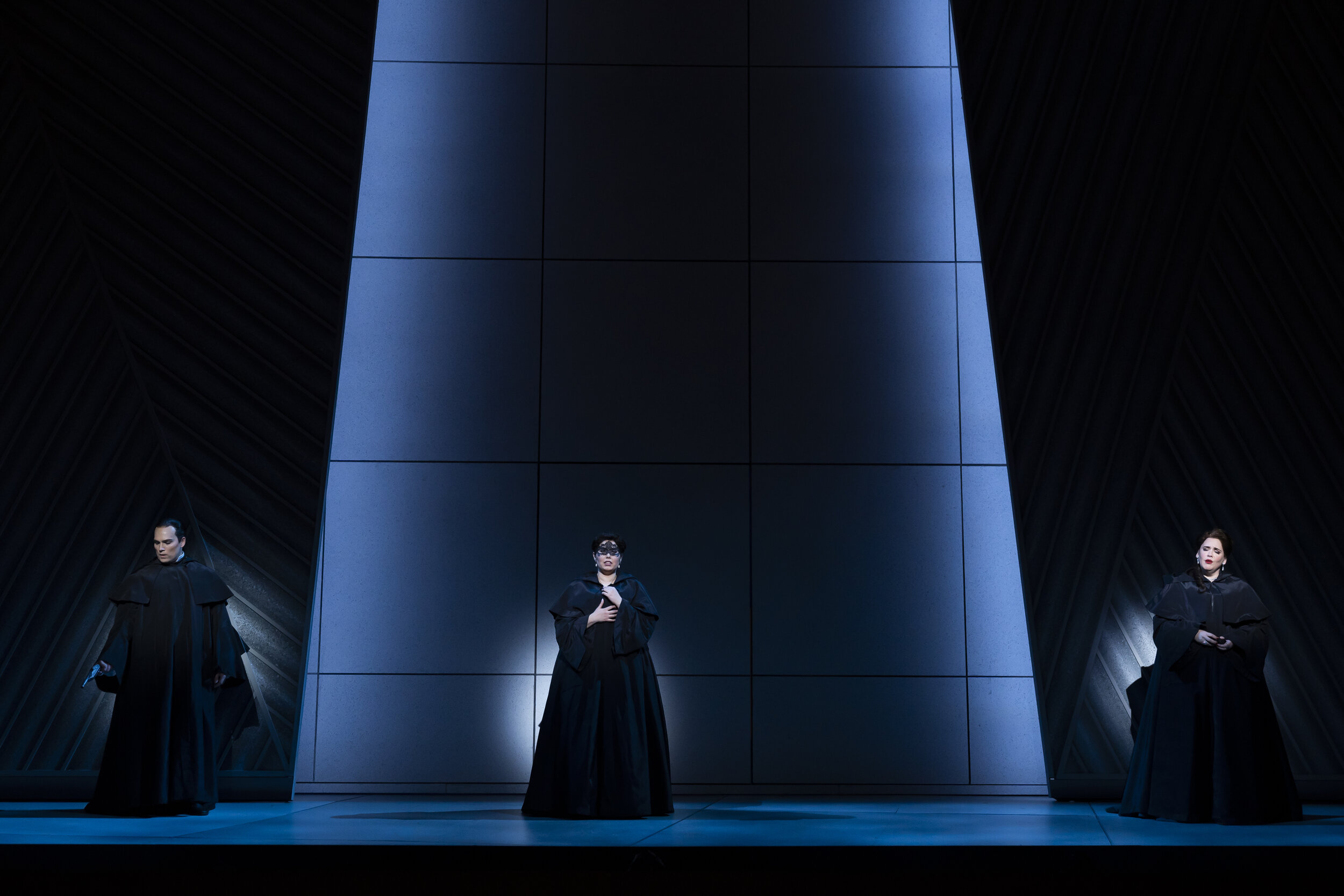WNO’s Artistic Director Francesca Zambello always puts on a good show. By good, I mean something different, interesting and entertaining in the way that an opera is presented, and WNO productions usually work for me. Halfway through Saturday night’s performance of Don Giovanni (1787), I wasn’t sure. The characters in marvelous period costumes moved about a stage of walls and beams in geometric designs with screens and lighting effects, only a few props or scene clues. From the standpoint of artistic craftsmanship and eye appeal, the abstract set was impressive; if it had been a modern art show, I would have given set designer Erhard Rom very high marks. It’s all quite worth seeing as an artistic light show. The floating question in my mind was whether Director E. Loren Meeker was able to present an engaging story-line with this set as backdrop.
Don Giovanni (Ryan McKinny) with images of his past in the frames. Photo by Scott Suchman; courtesy of Washington National Opera.
Frankly, I was also confused by the initial scene. Don Giovanni is based on the Spanish Don Juan myth of the early 17th century. Mozart’s Don uses his charm and the force of his wealth and power as a nobleman to make sexual conquests, over two thousand as the story begins, with the extent of his use of physical force left ambiguous in the opera. The opening scene has Giovanni sexually assaulting Donna Anna; when he tries to escape after she calls for help, she tries to restrain him. As presented, it was not clear in this opening scene that this was the action afoot. Then, her aging father, the Commendatore, rushes out to defend his daughter and is killed by Giovanni in a sword fight. Donna Anna extracts a vow of revenge from her fiancé Don Ottavio. Over the next day or so, Giovanni, traveling with his enabling mercenary Leporello, comes upon a previous conquest, Donna Elvira, whom he abandoned and who is now pursuing him for revenge, but in truth wants him back (he later seduces her maid ); he then encounters a young country girl, Zerlina, who he tries to seduce on her wedding day and later physically assaults her fiancé, Masetto. As his character degenerates, Giovanni comes face to face with a graveyard statue that talks (the Commendatore, miraculously constructed in less that 24 hours) and whom Giovanni invites to dinner. The dinner goes badly, and the Don is escorted to Hell all the while refusing to repent. The funny thing about Don Giovanni, the opera, is that it is also a comedy. Librettist Lorenzo Da Ponte labeled it a “dramma giocoso” or “jocular play”; Mozart called it an opera buffa. It’s actually quite funny, except for when it isn’t. In the end, it is God who takes revenge on Giovanni.
left: Vanessa Vasquez as Donna Anna; right: Keri Alkema as Donna Elvira. Photos by Scott Suchman; courtesy of Washington National Opera.
The orchestra under the direction of WNO Conductor Evan Rogister did a fine job of playing Mozart’s score, delivering some of Mozart’s greatest music, and seemed to me mostly in time with the singers. Overall, the cast of singers was marvelous. Even tenor Alek Shrader, who seemed to be holding back on his own, sang lovely harmony with soprano Vanessa Vasquez in duets. Ms. Vasquez was brilliant, with a beautiful tone, the best Donna Anna I have heard (please come back). Bass-baritone Ryan Mckinny was an excellent Giovanni, his actions and singing, smooth, refined, and polished. In an excellent cast, bass-baritone Kyle Ketelsen who sang the role of Leporello was a standout. His voice commanded the stage and his comic touches punctuated the entire evening. Soprano Keri Alkema’s acting and singing gave us a Donna Elvira who amused us and then softened our hearts; I remember her Tosca fondly from this past WNO season. Soprano Vanessa Becerra delighted our ears as a youthful Zerlina and showed both feminine strength with Masetto and feminine vulnerability with Giovanni. Baritone Norman Garrett was a convincing Masetto. Bass Peter Volpe was an effective, ineffectual defender of his daughter’s honor, and a fierce and foreboding ghost. Many of these singers were veterans of previous WNO productions. One of the benefits of Mozart’s operas is the incomparable ensemble numbers for two to six singers that he composed. The contributions of the chorus were also effective and pleasing under the direction of Steven Gathman.
left: Norman Garrett as Masetto and Vanessa Becerra as Zerlina; right: Alek Shrader as Don Ottavio, Norman Garrett as Masetto, and Kyle Ketelsen as Leporello. Photos by Scott Suchman; courtesy of Washington National Opera.
Getting back to the set and staging: at first, despite the visual appeal of the set, the placement of period costumes against the large, abstract set was simply confusing. The huge set of abstract lines, angles, and projection-created designs dwarfed the singers, and the contrast with the period costumes kept my focus from the singing and music. The set reminded me somewhat of a set used for Santa Fe Opera’s Cosi fan tutte this past summer; their set was composed of plain, even blank walls and flooring with exit doors, but the costumes were similarly non-suggestive. The elements of the story were presented almost devoid of time and place which made the story concentrated and timeless. I suggested it was a new form of opera that should be called “primal”. Perhaps this version of Don Giovanni might work better with non-descript costumes. After all, the story-line hasn’t really changed in over two hundred years.
Party scene with Don Giovanni (Ryan McKinny) seated while Leporello (Kyle Ketelsen) dances with the ladies. Photos by Scott Suchman; courtesy of Washington National Opera.
My feelings about the staging started to change with the party scene where the stage was more elaborately filled with party goers and a table and settings, a chandelier, and implied stairs and balcony with a large artwork in the background. This came close to the traditional staging with traditional costumes and anchored the story. However, we were soon back to the bare abstract set with location little designated. This, for me, was where Meeker’s presentation excelled over previous versions I’ve seen. I have always felt the opera drags a bit at this point moving around almost aimlessly. But by use of an abstract set here, the focus and emphasis is not on time and place, but on the music and singing; by that time I had accepted the costumes. I very much enjoyed this section of the opera, significantly more than in other productions I’ve seen. Ms. Meeker even showcased each of the major soloists with time on stage alone, with the abstract walls closed to place the singer in front of a partly textured wall of gray. This was very effective in highlighting arias, and each soloist took full advantage to please our ears and touch our hearts. Another highlight of the staging was director’s use of women, clothed in white gowns and period undergarments, intended as a tally of misdeeds that followed Giovanni as he moved through the opera, finally encircling him and closing in as he was consumed by Hell. In the end, I had mixed feelings about the set and staging that I have expressed, but overall, it worked for me, especially the second half, and I enthusiastically recommend it.
Don Ottavio (Alek Shrader), Donna Anna (Vanessa Vasquez), and Donna Elvira (Keri Alkema) disguised in their attempt to find and take revenge on Don Giovanni. Photo by Scott Suchman; courtesy of Washington National Opera.
Don Giovanni is one of the repertoire’s greatest operas, perhaps the greatest. But it is now old and worn. The great music is worthy of continued play. Making the opera fresh compels stage directors to experiment with different ways to present the story to keep it entertaining. WNO has done a good job. Right now, though, the sex and power issues addressed in Giovanni are keeping it fresh. WNO has keyed on this with the use of the white-clad women. The message for today is clear, even without the opera’s final scene where the survivors sing that Giovanni’s was the end coming to those that do evil. As was pointed out in the program booklet by Dramaturg Kelley Rourke and attributed to author Rebecca Solnit, “…#MeToo was not the beginning of women speaking up, but of people listening.”
The Fan Experience: Don Giovanni continues at the Kennedy Center on March 6, 8, 11, 14, 19, and 22. See the Don Giovanni webpage for information on pre-opera talks and artist Q&As.
WNO plans to capitalize on some upcoming productions to build on the awareness of issues raised through a Let’s Go There series of conversations. WNO has scheduled a conversation including Director Meeker, Anne Midgette, Linda Holmes, and Carina Chicano on March 14 in the Skylight Pavillon to explore “how Don Giovanni is a springboard into a larger cultural dialogue about the glamorization of the villain in opera and pop culture.”





![[l-r] Ryan McKinny (Don Giovanni), Norman Garrett (Masetto), Kyle Ketelsen (Leporello) in Don Giovanni -photobyScottSuchman .jpg](https://images.squarespace-cdn.com/content/v1/566de1d6df40f3a73187d87e/1583189664813-BV9L998YP5K7V8QT559C/%5Bl-r%5D+Ryan+McKinny+%28Don+Giovanni%29%2C+Norman+Garrett+%28Masetto%29%2C+Kyle+Ketelsen+%28Leporello%29+in+Don+Giovanni+-photobyScottSuchman+.jpg)

